Abstract
The effects of several beta-adrenoceptor blocking agents, [+), (-) and (+/-)-oxprenolol, p-oxprenolol, practolol, propranolol and timolol) were investigated on the ventricular arrhythmias occurring within the first 30 min of acutely ligating the main left coronary artery in anaesthetized rats. The degree of cardiac and vascular beta-adrenoceptor blockade was also assessed. All the compounds exhibited antiarrhythmic activity under these conditions. The degree of cardiac beta-adrenoceptor blockade required for this protection was less for the cardioselective agents, p-oxprenolol and practolol, than for the non-selective beta-adrenoceptor blocking agents. A comparison of the two isomers of oxprenolol demonstrated that the (-)-isomer markedly suppressed ischaemic arrhythmias (ventricular ectopic beats, incidence and duration of ventricular tachycardia and duration of ventricular fibrillation) more effectively than the (+)-isomer. Compounds possessing intrinsic sympathomimetic activity (ISA) caused less marked haemodynamic changes (in equivalent beta-blocking doses) than those that did not possess this ancillary property. The membrane stabilizing activity of oxprenolol and p-oxprenolol did not appear to contribute to the antiarrhythmic activity of these agents; however, the membrane stabilizing activity of propranolol may contribute to its effectiveness. In all the drugs studied, the main pharmacological property required to suppress early postischaemic arrhythmias is blockade of cardiac beta-adrenoceptors.
Full text
PDF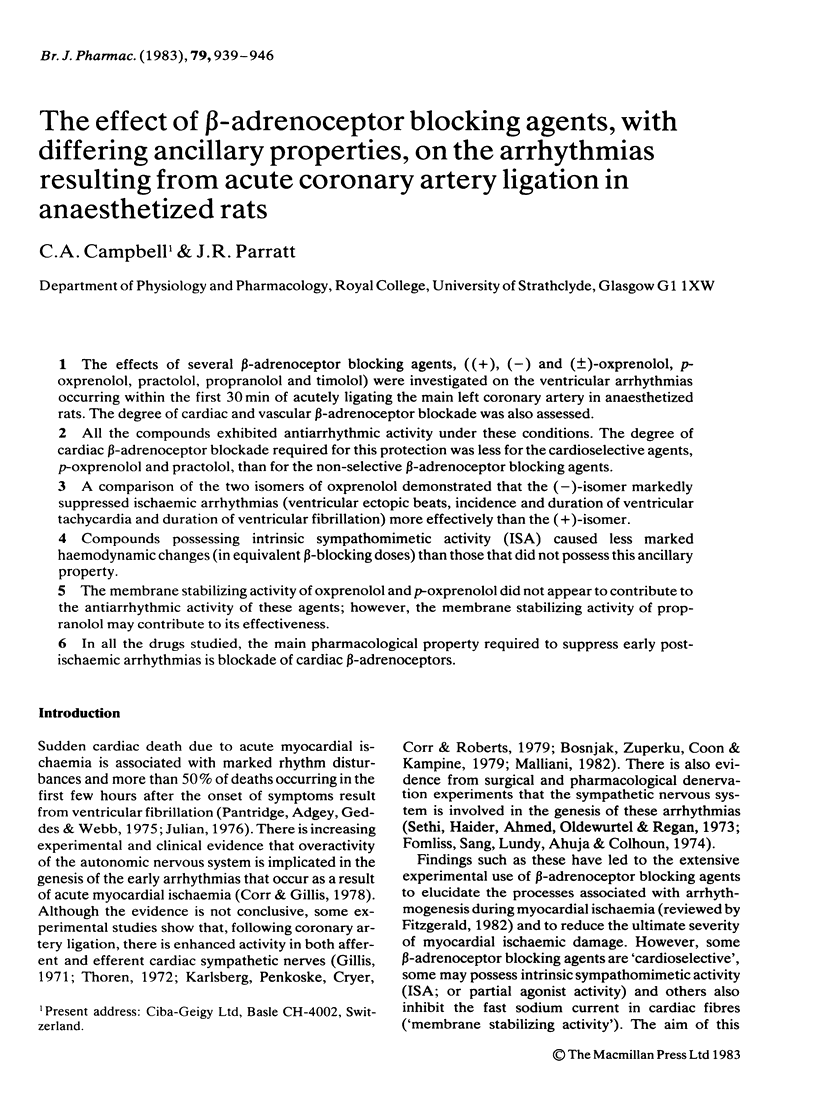
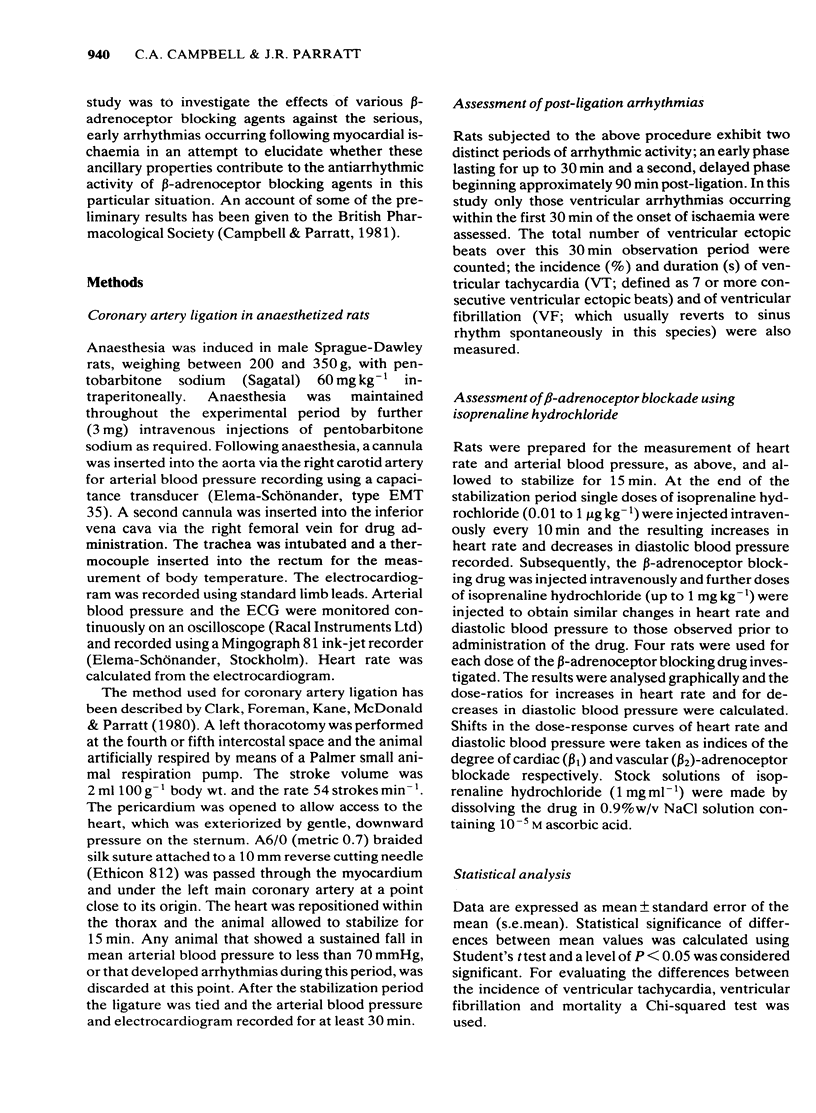
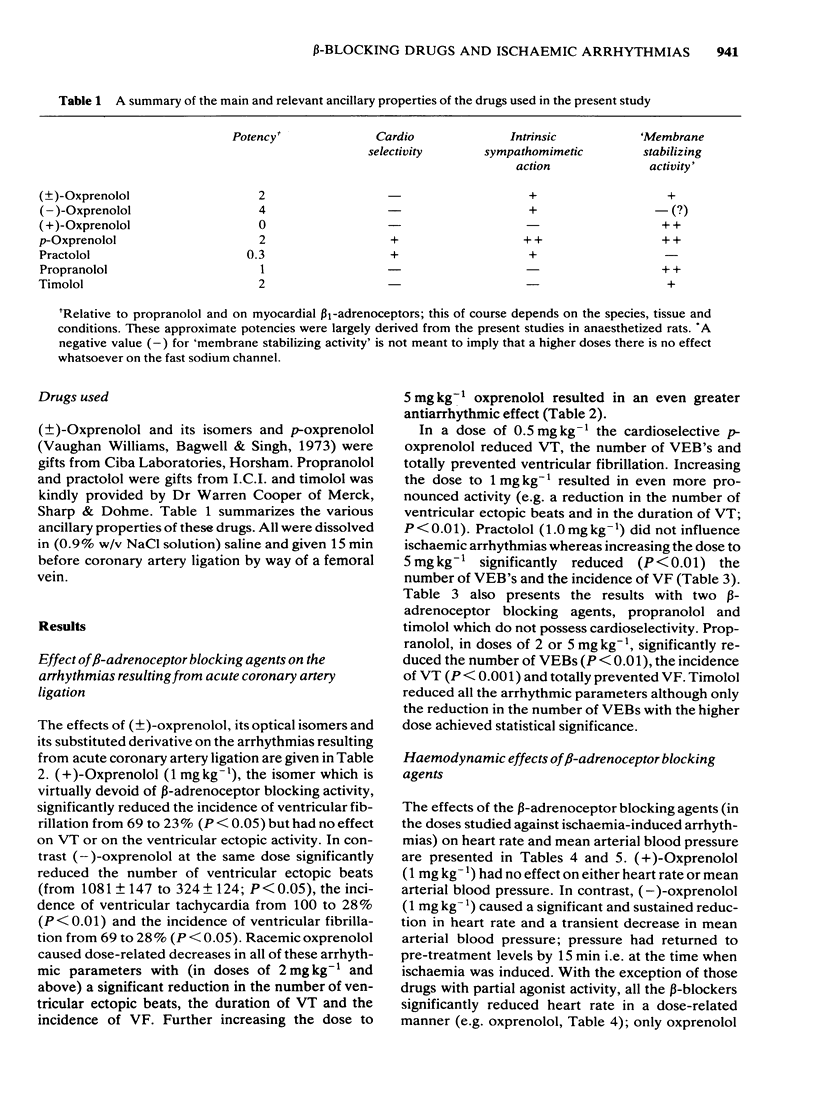

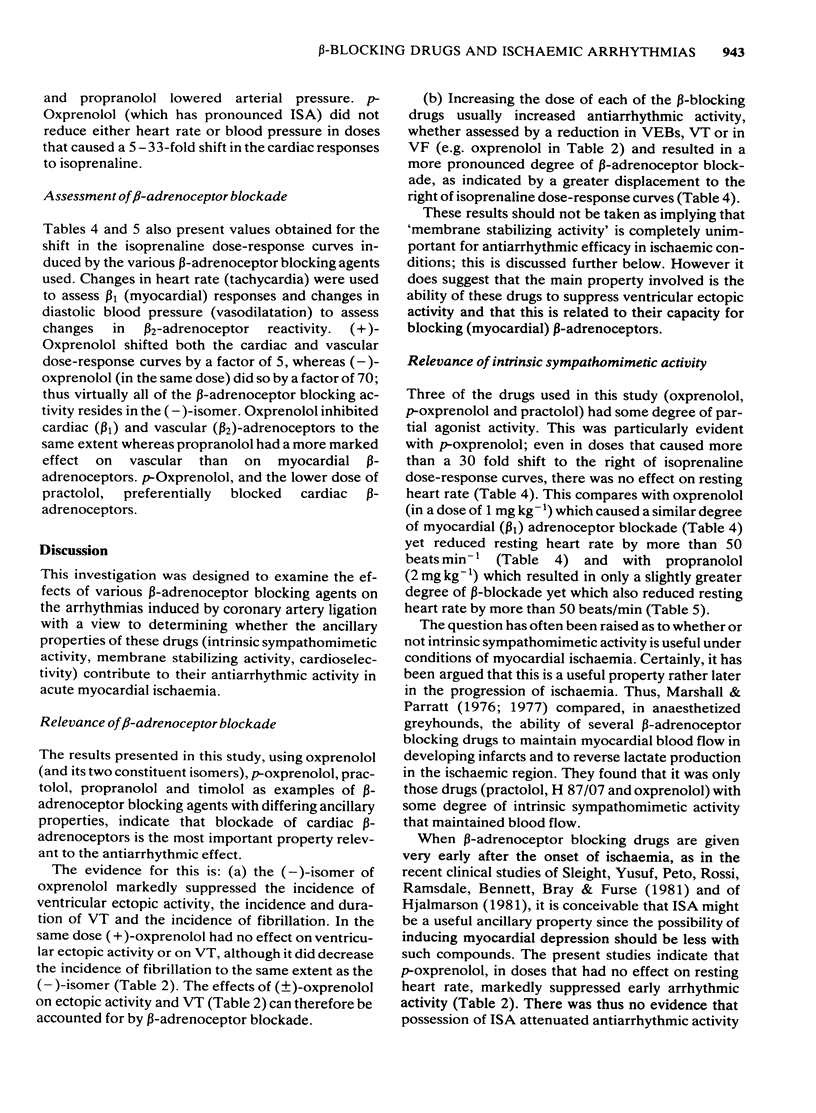
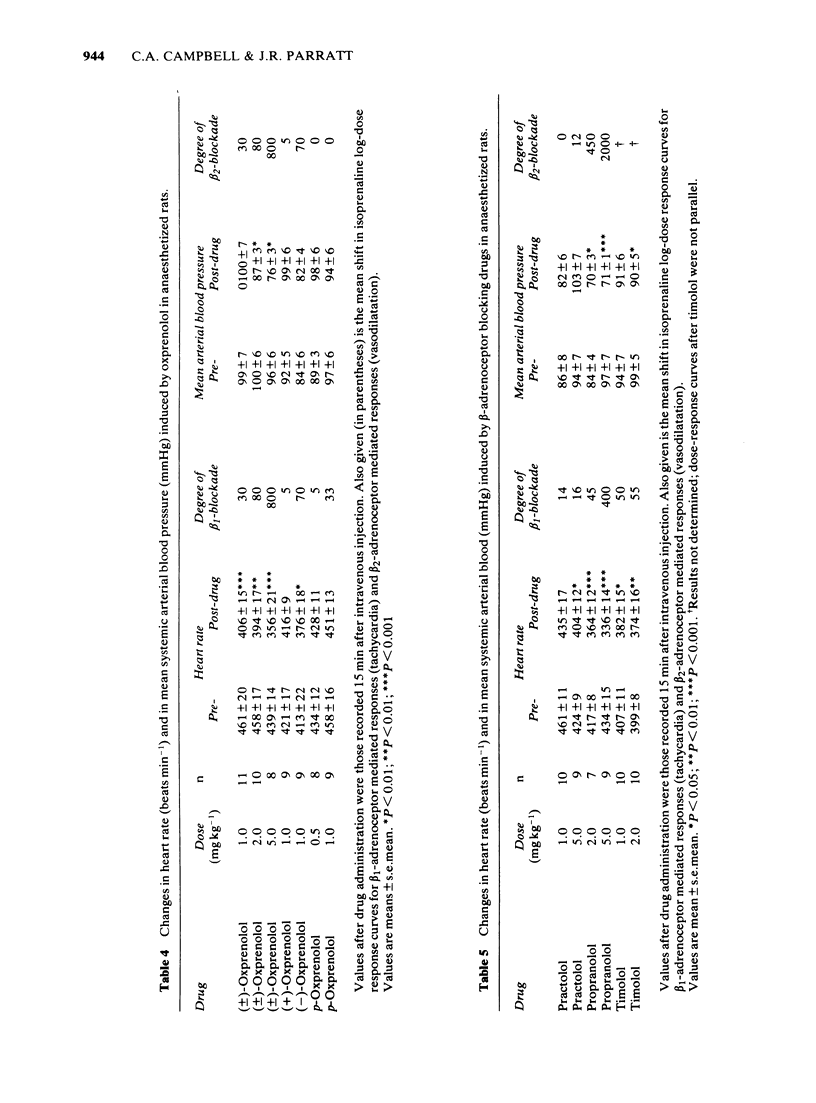
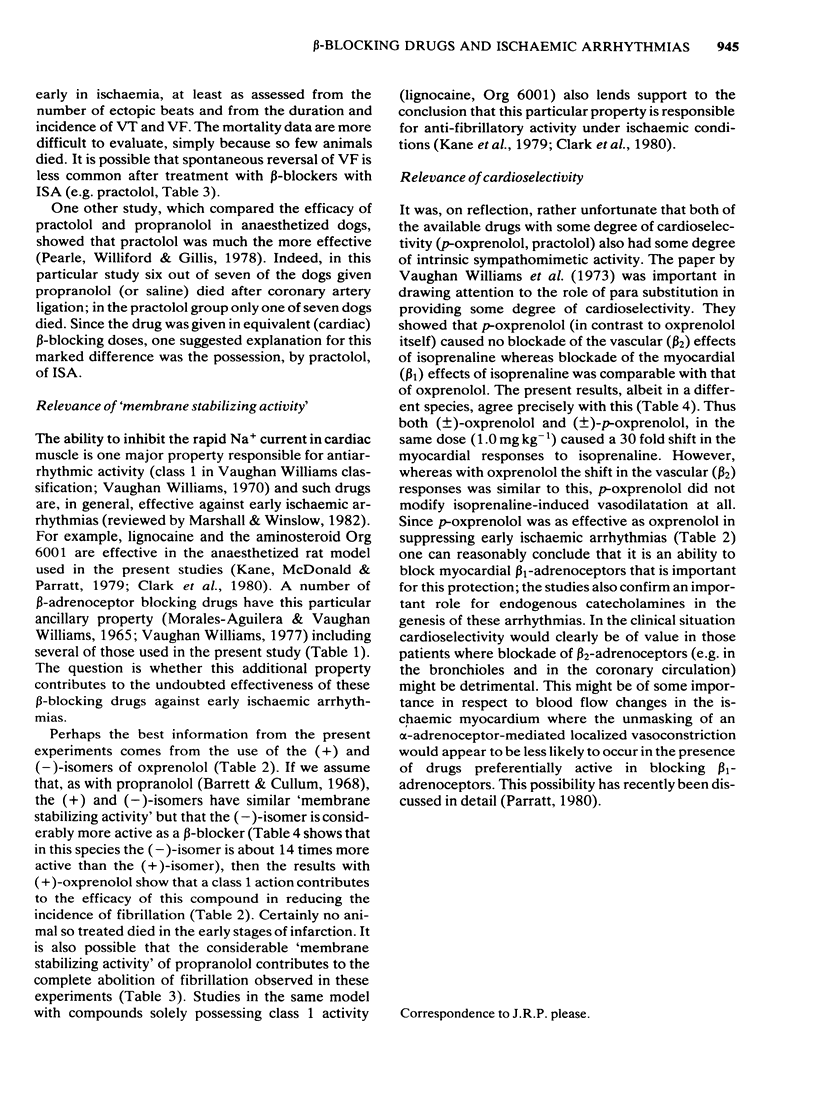
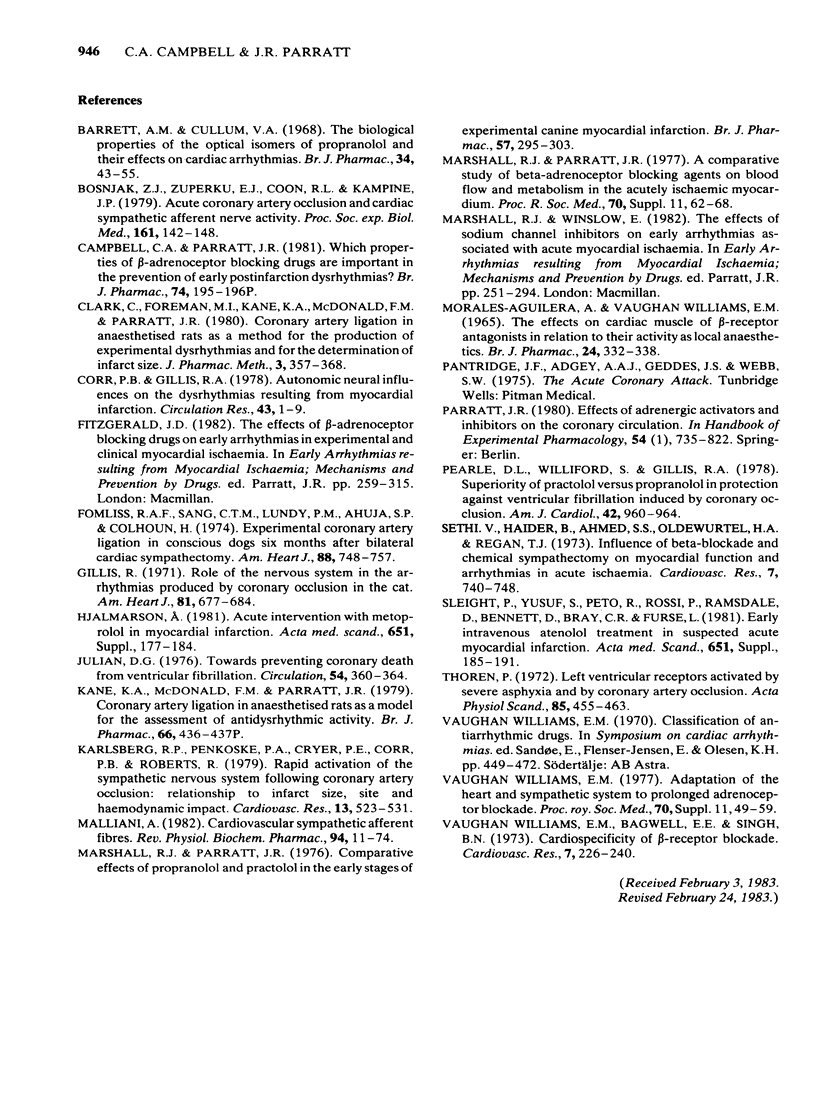
Selected References
These references are in PubMed. This may not be the complete list of references from this article.
- Bosnjak Z. J., Zuperku E. J., Coon R. L., Kampine J. P. Acute coronary artery occlusion and cardiac sympathetic afferent nerve activity. Proc Soc Exp Biol Med. 1979 Jun;161(2):142–148. doi: 10.3181/00379727-161-40507. [DOI] [PubMed] [Google Scholar]
- Clark C., Foreman M. I., Kane K. A., McDonald F. M., Parratt J. R. Coronary artery ligation in anesthetized rats as a method for the production of experimental dysrhythmias and for the determination of infarct size. J Pharmacol Methods. 1980 Jun;3(4):357–368. doi: 10.1016/0160-5402(80)90077-7. [DOI] [PubMed] [Google Scholar]
- Corr P. B., Gillis R. A. Autonomic neural influences on the dysrhythmias resulting from myocardial infarction. Circ Res. 1978 Jul;43(1):1–9. doi: 10.1161/01.res.43.1.1. [DOI] [PubMed] [Google Scholar]
- Fowlis R. A., Sang C. T., Lundy P. M., Ahuja S. P., Colhoun H. Experimental coronary artery ligation in conscious dogs six months after bilateral cardiac sympathectomy. Am Heart J. 1974 Dec;88(6):748–757. doi: 10.1016/0002-8703(74)90285-3. [DOI] [PubMed] [Google Scholar]
- Gillis R. A. Role of the nervous system in the arrhythmias produced by coronary occlusion in the cat. Am Heart J. 1971 May;81(5):677–684. doi: 10.1016/0002-8703(71)90011-1. [DOI] [PubMed] [Google Scholar]
- Hjalmarson A. Acute intervention with metoprolol in myocardial infarction. Acta Med Scand Suppl. 1981;651:177–184. doi: 10.1111/j.0954-6820.1981.tb03654.x. [DOI] [PubMed] [Google Scholar]
- Julian D. G. Toward preventing coronary death from ventricular fibrillation. Circulation. 1976 Sep;54(3):360–364. doi: 10.1161/01.cir.54.3.360. [DOI] [PubMed] [Google Scholar]
- Karlsberg R. P., Penkoske P. A., Cryer P. E., Corr P. B., Roberts R. Rapid activation of the sympathetic nervous system following coronary artery occlusion: relationship to infarct size, site, and haemodynamic impact. Cardiovasc Res. 1979 Sep;13(9):523–531. doi: 10.1093/cvr/13.9.523. [DOI] [PubMed] [Google Scholar]
- MORALES AGUILERA A., VAUGHANWILLIAMS E. M. THE EFFECTS ON CARDIAC MUSCLE OF BETA-RECEPTOR ANTAGONISTS IN RELATION TO THEIR ACTIVITY AS LOCAL ANAESTHETICS. Br J Pharmacol Chemother. 1965 Apr;24:332–338. doi: 10.1111/j.1476-5381.1965.tb01719.x. [DOI] [PMC free article] [PubMed] [Google Scholar]
- Marshall R. J., Parratt J. R. Comparative effects of propranolol and practolol in the early stages of experimental canine myocardial infarction. Br J Pharmacol. 1976 Jun;57(2):295–303. doi: 10.1111/j.1476-5381.1976.tb07479.x. [DOI] [PMC free article] [PubMed] [Google Scholar]
- Pearle D. L., Williford D., Gillis R. A. Superiority of practolol versus propranolol in protection against ventricular fibrillation induced by coronary occlusion. Am J Cardiol. 1978 Dec;42(6):960–964. doi: 10.1016/0002-9149(78)90682-3. [DOI] [PubMed] [Google Scholar]
- Sethi V., Haider B., Ahmed S. S., Oldewurtel H. A., Regan T. J. Influence of beta blockade and chemical sympathectomy on myocardial function and arrhythmias in acute ischaemia. Cardiovasc Res. 1973 Nov;7(6):740–747. doi: 10.1093/cvr/7.6.740. [DOI] [PubMed] [Google Scholar]
- Sleight P., Yusuf S., Peto R., Rossi P., Ramsdale D., Bennett D., Bray C., Furse L. Early intravenous atenolol treatment in suspected acute myocardial infarction. Acta Med Scand Suppl. 1981;651:185–192. doi: 10.1111/j.0954-6820.1981.tb03655.x. [DOI] [PubMed] [Google Scholar]
- Thorén P. Left ventricular receptors activated by severe asphyxia and by coronary artery occlusion. Acta Physiol Scand. 1972 Aug;85(4):455–463. doi: 10.1111/j.1748-1716.1971.tb05283.x. [DOI] [PubMed] [Google Scholar]
- Williams E. M., Bagwell E. E., Singh B. N. Cardiospecificity of -receptor blockade. A comparison of the relative potencies on cardiac and peripheral vascular -adrenoceptors of propranolol, of practolol and its ortho-substituted isomer, and of oxprenolol and its para-substituted isomer. Cardiovasc Res. 1973 Mar;7(2):226–240. doi: 10.1093/cvr/7.2.226. [DOI] [PubMed] [Google Scholar]


